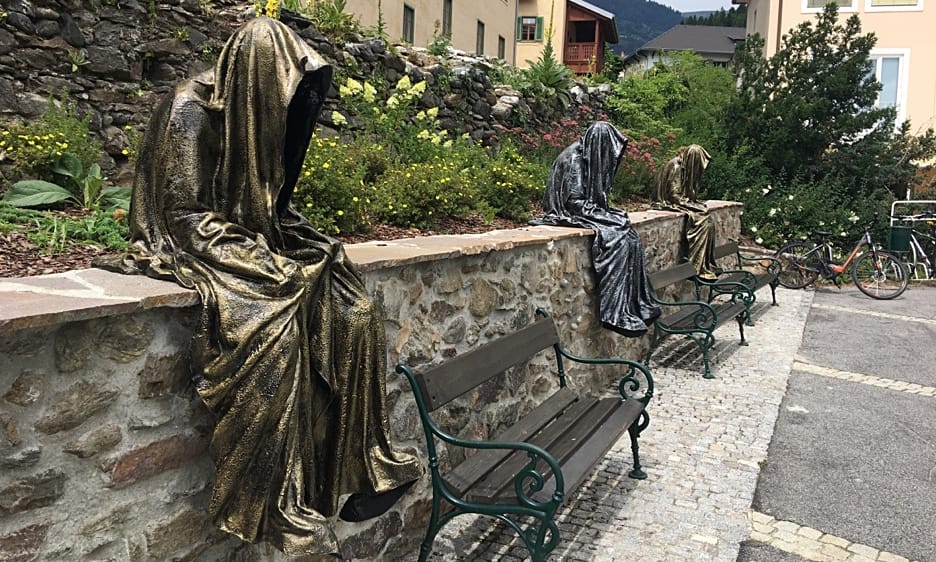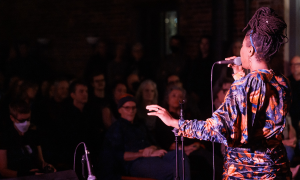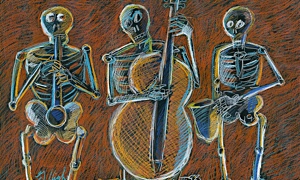Home » Jazz Articles » What is Jazz? » From Medieval to Live Evil: We're All Minimalists Now
From Medieval to Live Evil: We're All Minimalists Now

A Brief History of the Minimalist Aesthetic
Minimalism is defined by Merriam-Webster as "a style or technique (as in music, literature, or design) that is characterized by extreme spareness and simplicity." Musically speaking, this translates to a few characteristics common to most pieces:- Slow-moving or static harmony;
- Small number of repetitive and simple rhythmic figures;
- Use of modes rather than the major/minor scales, resulting in a weaker tonality that is less directional;
- Overall effect is reflective (often contemplative or dreamy) rather than discursive.
This sacred music eschews any recognition or valorization of the listener's ego, instead, it disposes the listener to reflection and contemplation of the infinite and the ineffable. The minimalist aesthetic is well- suited to these goals. In particular, this music uses the seven modes identified by the Ancient Greeks, which, because they are used exclusively in this early church music, are now called the "Church Modes." As classical music developed after Gregorian Chant, it abandoned the Church Modes," and, from roughly 1600 until 1900, utilized the major and minor scale as the primary source of melodic and harmonic materials. Why did they avoid the modes? The answer is that the major scale (which is one of the Church Modes, named the "Ionian Mode") and the minor scale (which is a hybrid of another of the Church Modes, the "Aeolian Mode" with the Ionian) provide a much more powerful sense of tonality, and with that, an enormous potential for expanded musical narrative and range of emotional expression.
Remarkably, these scales were so rich that they provided many composers (including Bach, Mozart, Beethoven, Brahms Schubert, Chopin, Verdi, Wagner, and countless others from 1600-1900) with enough variation to express themselves in exquisitely unique and highly delineated ways. However, after 300 years, this enormous reservoir had been exhausted, and composers began to seek out other resources. In particular, French composers, like Hector Berlioz, Emmanuel Chabrier, Gabriel Fauré, and others, were beginning to explore timbre as a primary feature of their music, taking the first steps away from the music's reliance on the powerful harmonic movements that were its engine for so many centuries. It was Claude Debussy, however, who definitively made the great leap forward by writing music that broke with the major/minor scale system and introduced the world to music in which timbre, tone color, and texture, were the defining features. And thus, in many of Debussy's pieces, a minimalist aesthetic reemerges at the close of the 19C in France.
Not surprisingly, one of the musical materials best suited to this evocative and generally more contemplative pursuit was the old Church Modes, which had been ignored, as mentioned previously, by the classical tradition for 300 years. Debussy and others, like Maurice Ravel, and the inimitable Erik Satie, utilized the Church Modes to great effect, giving us some of the most popular and memorable classical music of the early 20C.
Impressionism to Impressions: The Minimalist Aesthetic in Jazz
In the early 1900s, jazz enters the scene and quickly becomes a popular music sensation across the country, and eventually around the world. At the beginning, there are no minimalist tendencies to be found. The first jazz style, Dixieland (1900-1930) features a great deal of group improvisation, in particular, simultaneous improvisation in the same register by the clarinet and cornet/trumpet, which results in a rather dense polyphonic texture. There are a few hints of a more subdued approach is to be found, in some of Bix Beiderbecke's music, for example, but it can hardly be called "minimalist." Dixieland is dominated almost entirely by the high energy rhythms that one would expect to accompany the dance practices of the time.The Swing Era (1930-1945) moves away from the polyphonic group improvisation, preferring instead a homophonic texture where one main melody (or soloist) is featured while the rest of the ensemble is relegated to an accompanying role. This is exactly what happened in the western classical tradition as the polyphonic Baroque Era (1600-1750) faded in favor of the homophonic Classical Era (1750-1825). [It is fascinating to note the similarities in how these styles, separated by time, culture, and disposition, developed in structurally similar ways, which I will highlight as the phenomenon occurs and reoccurs.] There are, however, hints of minimalism that appear in the Swing Era—Claude Thornhill's "Snowfall," for example, exhibits glimpses of a more subdued aesthetic—but overall the era is again dominated largely by energetic dance music.
While the Swing Era remains dance-oriented, some of its most innovative composers are, almost from the beginning, foreshadowing the next era. Duke Ellington, for example, was utilizing advanced harmony from 20C classical composers like Igor Stravinsky and incorporating it successfully in his piano playing and his big band music. The Bebop Era (1940-1950) continued this pursuit and ushered in an era of extremely sophisticated and complex harmonies that are taken directly from the 20C classical masters like Debussy, Ravel, Prokofiev, and Stravinsky (with whom Charlie Parker was particularly enamored). As before, this move toward greater harmonic complexity and increased dissonance as jazz developed from Swing to Bebop, also mirrors what happened in classical music as the Classical Era moved to the Romantic Era (1820-1910).
Bebop, however, did not last long—its dazzling instrumental pyrotechnics, breakneck tempos, sophisticated harmonies, and its (eventually) formulaic improvisations were, apparently, too limiting for the next generation of musicians. While short-lived, Bebop's legacy is profound; it provided the musical foundation for many of the styles that followed.
A great flowering of styles emerged from Bebop but two closely related styles emerged that were decidedly different—Cool Jazz and Modal Jazz, the latter of which is exemplified exquisitely by the highest selling jazz album of all time, Miles Davis' Kind of Blue. These styles consciously avoided the melodic and harmonic formulae that had been standardized in both the Swing and Bebop eras, and in so doing, steered the music in exciting new directions that vastly expanded its emotional breadth.
It is here that we find, for the first time, the harmonies, modalities, and minimalist aesthetic of the French Impressionists appearing in jazz as a defining feature of the music. Davis hired the classically-trained pianist, Bill Evans, to play on this album, ostensibly because Evans brought with him a deep understanding of the modal, extended tertian, and quartal and quintal harmonies of the French Impressionists and other 20C classical composers. Evans' playing and his composition skills (the stunning ballad, "Blue in Green," while credited to Davis, is clearly an Evans composition) allowed Davis to realize the striking new vision he had for this music. Once again, we see the same developments in jazz as in classical music—at the end of the harmonically complex Romantic Era of classical music, a new style (Impressionism) appears that uses the old Church Modes, along with rich tertian harmonies that are regularly used without requiring them to move towards their tonally logical destinations. The same thing happens here as the powerful teleological harmonic complexities of the Bebop era are jettisoned by Cool and Modal Jazz, both of which preferred a markedly more relaxed approach to harmony, among other things.
In this instance, however, the two genres, jazz and classical, intertwine in a remarkable manner, with one genre (Jazz) subsuming the musical materials and aesthetic values of a previous style (Impressionism) from an entirely different genre (Classical) that itself was a movement away from the complexity of its predecessor. It is remarkable to see how artistic temperaments across centuries and disparate cultures nonetheless demonstrate such similar developmental patterns.
Rebirth of the Cool: The Rise of Minimalism
We now finally arrive at the 1960s, the era in which Minimalism emerged as a fully delineated style—but from where did it emerge? It came, in large part, from jazz and other ethnic folk and classical traditions that featured, like jazz, powerful and sophisticated rhythms. The four luminaries who founded the style, La Monte Young (b. 1935), Terry Riley (b. 1935), Steve Reich (b. 1936), and Philip Glass (b. 1937), grew up during the heyday of jazz, and witnessed the flowering of creative activity that took place as the music developed through its style periods from Swing, Bebop, Cool and Modal Jazz, and then to the avant-garde music of the 1960s. Terry Riley, who played piano bars to make a living in his early days, talks openly about the influence of jazz on his composing:The periods of jazz when I was listening the most was the time of the really great chamber music groups of John Coltrane and Miles Davis, Charles Mingus, Bill Evans and Gil Evans. There was a lot about their approach that I studied and found very useful in my own work. One of their ideas was taking just a very simple chart and building a very comprehensive piece out of it; it sounds like it might be all written out, and they were all doing that just because they were great improvisers. What really impressed upon me was that you can start with very limited means, and if you have great players you can evolve into quite an engaging structure.
Likewise, so does Steve Reich, who was a drummer and pianist:
When I was 14, life really changed musically. And the seeds for whoever I've become were sown in that year. I'd never heard any jazz...At the age of 14, through a number of friends, I heard recordings of the "Rite of Spring," the Fifth Brandenburg [Concerto], Charlie Parker, Miles Davis, and the drummer Kenny Clarke. And it was very much as if you'd lived in a house and someone said, "Well, you're 14 now and there's a room in the house you haven't seen." They opened the door, I walked in the room, and I never really left...
I became a composer because I loved Bach, because I loved Stravinsky, because I loved jazz...
And at about the same time that was going on I was listening to John Coltrane when he was playing "My Favorite Things" and on what became "modal jazz," but what you could describe, very simply, as "playing a lot of notes to very few harmonies." An [album] like Africa Brass, which really impressed me, was basically a half an hour in [the key of] "F." Jazz musicians say, "Hey man, what's the changes?" "F." "No! F for half an hour!"
These composers, as young artists, absorbed basic elements of the jazz aesthetic—most notably its powerful rhythmic drive, its improvisatory spirit, its unpredictability, and also the harmonic approach found in the Modal and Avant-Garde periods, where harmonic movement was emancipated from its traditional, goal-oriented practices in the Swing and Bebop eras.
We're All Minimalists Now
And now to the present day. Here is a list of the classical music winners* of the Pulitzer Prize in music since 2008:- 2019 p r i s m, by Ellen Reid
- 2017 Angel's Bone, by Du Yun
- 2015 Anthracite Fields, by Julia Wolfe
- 2014 Become Ocean, by John Luther Adams
- 2013 Partita for 8 Voices, by Caroline Shaw
- 2012 Silent Night: Opera in Two Acts, by Kevin Puts
- 2011 Madame White Snake, by Zhou Long
- 2010 Violin Concerto, by Jennifer Higdon
- 2009 Double Sextet, by Steve Reich
- 2008 The Little Match Girl Passion, by David Lang
Only three (2010, 2011, and 2012) are written in a style that closely aligns with earlier composition practices; they are complex, motivically rich, and they are developmental, by which I mean that they develop musical ideas in an organic process of musical growth and musical dialogue, much in the same way that has been done by most classical composers since the Baroque era. In a word, to coin the term used by the British musicologist, Julian Johnson, this music is discursive, creating musical narrative and "conversation," if you will, that must be approached as such by the listener. It's not easy listening—it's unpredictable, dissonant, and at times jarring.
The other seven are either minimalist or show strong minimalist influences. That is not to say that they are all written in the same style—minimalism is 60 years old, and has been enriched by other styles and influences; at this "mature" stage, there are many variations from its initial iterations. For example, Steve Reich's Double Sextet is written in the more traditional minimalist style that defined the genre in the first place—limited number of motifs, modal tonality, repetitive figures and "loops" that can phase in and out, a groove-oriented approach with a focus on the rhythmic subtleties found in pop music and jazz. This style is easy to listen to— there are (generally) no harsh dissonances, the music is not jarring or unpredictable, and while the music does "grow" texturally and rhythmically, it eschews the teleological approach found in most classical music. The overall effect is contemplative and time-bending, creating a serene stasis, a dimension of suspended reality not unlike the effect created by the Gregorian Chant with which we began this exploration.
It appears then, that the experts have spoken—70% of recent Pulitzer classical winners of the last decade are minimalists (or minimalist leaning). It's hard not to see this as a clear message that Minimalist music and its aesthetic reigns supreme in classical music, with no close second—it is, if the Pulitzers are any measure, the dominant classical music of our time and its reach in our culture is wide and deep. Hardly any musical genre has escaped being, at least, influenced by its profound upheaval of classical music aesthetics in the mid-20C. We find it used in rock and pop of various stripes (The Who, Pink Floyd, Genesis, King Crimson, David Bowie, Porcupine Tree, Laurie Anderson, Magna Carta Cartel, Caspian, Velvet Underground), Jazz (Kenny Wheeler, Tomasz Stańko, Peter Erskine), Ambient Music (Brian Eno, David Byrne, David Sylvian), EDM (Trentemoller, Fever Ray, M83) and other electronic music, and of course, in film music, where it is found regularly. Its influence is found not only in music, it is found in all of the arts. There is minimalist film, art, literature and poetry, architecture, and even interior design and fashion! With so much demand for minimalism, it's not surprising that we're teaching it in our colleges and universities, especially in music departments where most young composers quickly attach themselves to the style. And why not? The appeal is as obvious as it is irresistible: Some 60 years later, it still retains an aura of stylistic subversion and counterculture values, while at the same time, it also signifies refinement, sophistication and intellectual seriousness. These are lofty heights for young neophytes who instantaneously emerge as "composers" at the end of a semester of study. (Well, truth be told, it's the easiest style to imitate, poorly in most cases, but it does allow for people with little or no skills or training to immediately participate in the creative process.)
Why has this genre become so popular? If I can be allowed to conjecture a bit here, I believe the answer is not difficult to ascertain. We live in an age where contemplative and quiet spaces have largely been eradicated by the communication technologies that increasingly prevent us from being, in a real sense, alone in the same way as people regularly were even 50 years ago. Even traditional (denominational) places of worship** in which we collectively practiced silence and where contemplative music predisposed us to prayer and reflection have been abandoned in favor of non-denominational churches that feature pop music, light shows, and multimedia spectacles that are virtually indistinguishable from rock concerts.
Our public and private spaces, both sacred and secular, have changed drastically in the last 20-30 years, but our physical and emotional need for silence and contemplative practices has not. This brings us back to Gregorian Chant, referenced at the beginning of this article, whose purpose was to assist in creating the proper environment for worship: the ego is subdued, the mind is silenced, time passes differently, and we can enter a contemplative state in which communing with the infinite is possible. In other words, the effects of Gregorian Chant are virtually indistinguishable from those of Minimalism. I do not think this is a coincidence; I believe Minimalist music is sacred music made secular, and therein lies its attraction and its success. It is the ghost of the monastery that haunts the modern world.
**I am speaking here of Christian sects; I am not aware of this phenomenon occurring in mosques, synagogues or Buddhist temples.
Epilogue: Millstatt am See, Austria
Millstatt am See is a picturesque mountain town in south-western Austria, not far from the Italian border. As legend would have it, when Domitian, the ruler of the region, converted to Catholicism in 809, he ordered hundreds and hundreds of pagan statues to be thrown into the lake, hence the name "Mill (thousand)-Statt (statue)." A Benedictine monastery was established there in 1070, which went through several changes of ownership, and was eventually abandoned in the late 18C. The buildings are still there, but the monastery is gone. Ironically, the memory of the monastery is kept alive by statues, statues of monks that haunt the town, faceless figures in prayer, heads bowed in reverence for a monastery that is no longer there.
Tags
PREVIOUS / NEXT
Support All About Jazz
 All About Jazz has been a pillar of jazz since 1995, championing it as an art form and, more importantly, supporting the musicians who make it. Our enduring commitment has made "AAJ" one of the most culturally important websites of its kind, read by hundreds of thousands of fans, musicians and industry figures every month.
All About Jazz has been a pillar of jazz since 1995, championing it as an art form and, more importantly, supporting the musicians who make it. Our enduring commitment has made "AAJ" one of the most culturally important websites of its kind, read by hundreds of thousands of fans, musicians and industry figures every month.





















